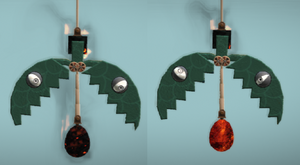Flame Tool: Difference between revisions
m (→Early Revision) |
|||
| Line 46: | Line 46: | ||
Before the flame hazard became a general tool that can be used on most objects, it was going to be a simple material that had the flame hazard properties. The gmat for said material exists in retail versions of the games and can still be found hidden in some LBP1 objects, most notably the fireball inside the "Hanging Snapping Claw". | Before the flame hazard became a general tool that can be used on most objects, it was going to be a simple material that had the flame hazard properties. The gmat for said material exists in retail versions of the games and can still be found hidden in some LBP1 objects, most notably the fireball inside the "Hanging Snapping Claw". | ||
[[File:"Hanging Snapping Claw" early flame.png| | [[File:"Hanging Snapping Claw" early flame.png|thumb|When the fireball in this object is unlethalised, it reveals an early revision of the flame hazard, this material can be used like other materials and is not hazardous.]] | ||
Revision as of 07:20, 5 April 2023
The Flame Tool makes an object burn with lethal flames.
Tool Usage
The Flame Tool can be used on any object or material in any layer, as long as it has a hitbox.
Hover over the item you wish to lethalise, and press ![]() .
.
You can press ![]() again to unlethalise it, or use the Unlethalise Tool.
again to unlethalise it, or use the Unlethalise Tool.
Hazard
Burning
When a player makes contact with the hazard, they will be burned.
The player will bounce off in a direction opposite of where they made contact with the hazard, carrying any previous momentum.
If two burns are sustained within the timeframe that it takes to play the burn animation, (about 1.2 seconds) the player will be killed on the second burn.
This applies even after the player has died and respawned, so being burned within the timeframe of the previous burn will kill the player instantly.
Being burned entirely, will result in the player being killed instantly. This can happen for example if a hologram or other non-collision object that has the flame hazard is over Sackboy's entire hitbox, by emitter or if its placed over a checkpoint and Sackboy spawns in.
Burn Location
Sackboy will have a different reaction depending on where the player makes contact with the flames.
Being burned on the lower half of the body will spawn fire particles at Sackboy's feet, and Sackboy will play a stomping animation.
Being burned on the upper half of the body will spawn fire particles at Sackboy's head, and Sackboy will play a fanning animation.
In early footage, it can be seen that being burned on the upper half of the body will stun Sackboy, playing an animation of Sackboy falling over and causing a short period where Sackboy can't move.
Powerup Removal (LBP1 Only)
If a player touches the hazard while they have a powerup equipped, the powerup will be removed. This only applies in the first game, and was removed in subsequent games, breaking existing levels that took advantage of the property.
Powerup removal does not apply to the Scuba Gear powerup.
Dousing
In a level with Global Water, the hazard can be doused.
When the entire hitbox of the hazard is submerged in water, the item will be doused, turning back to a non-lethal state.
The hazard will still be applied if only part of the hitbox is submerged in water.
Tweaks
Audio Tweak (LBP2 Onwards)
Visuals (LBP3 Only)
Early Revision
Before the flame hazard became a general tool that can be used on most objects, it was going to be a simple material that had the flame hazard properties. The gmat for said material exists in retail versions of the games and can still be found hidden in some LBP1 objects, most notably the fireball inside the "Hanging Snapping Claw".
